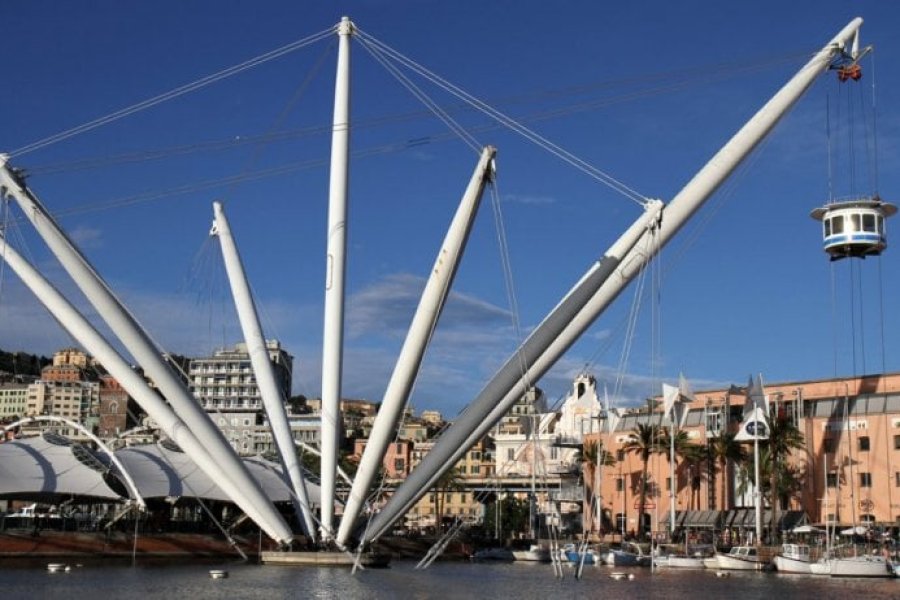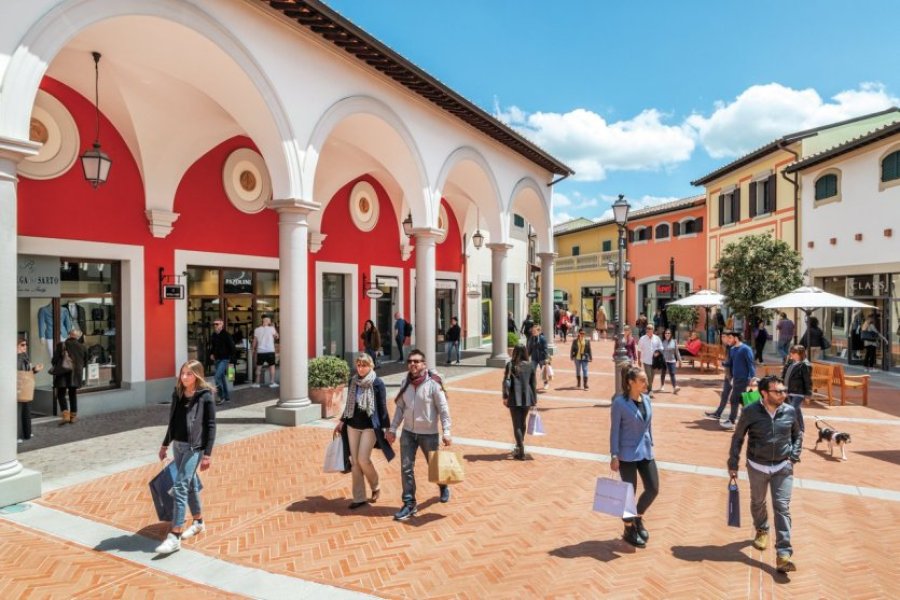Travel guide Genoa
Genoa (Genova), the first port ofItaly, is the capital of Liguria, a region in northwestern Italy. Known for the central role it played in maritime trade for centuries, it is today a very dynamic student, scientific, sports and cultural city. Although it is at the forefront of fashion and technology, it is also home to a rich heritage and its old town has been declared a world heritage site for its New Streets with the 43 Rolli Palaces. And one can imagine the splendor that was Genoa's! There is also an exceptional concentration of religious buildings: 28 churches, 6 sanctuaries, 5 basilicas, the Romanesque cathedral of San Lorenzo, a synagogue... Narrow streets lead to the Piazza de Ferrari and the Teatro Carlo-Felice opera house. Climb to the top of the Lantern, Genoa's medieval lighthouse, to discover the magnitude of the industrial port and its countless containers, go for a dip in the sea, visit the little-known Chiossone Museum of Japanese and Asian Art, the Aquarium and the Museum of the Sea. Some may be reluctant to point out that Genoa is also the birthplace of Italian soccer. Finally, you should know that the city has seen the birth and development of many prestigious people, the most famous of whom was Christopher Columbus. As for Genoa's cuisine, it will delight you with specialties such as pesto (yes!), focaccia, burrida, wild herb soup, nettle farinata, stuffed dishes... Consult your favorite tourist guide to find the best addresses to discover it.
Discover also our special report: Genoa, an amazing city, an extraordinary travel destination
What to see, what to do Genoa?
-
Book an activity
-
Customized travel
- Addresses to visit Genoa
When to go Genoa ?
In Genoa, the low tourist season is during the months of January, February, March, November and December. The high tourist season is very extensive, from the beginning of April to the end of October, with a peak in July and August when the tourist numbers are at their highest. For the lowest hotel rates, choose October. Conversely, September is the month when rates are highest for accommodations. As for the weather, it is mild all year round, except for a few days. Heritage lovers will enjoy the Rolli Days (a weekend at the end of May), open days in the Rolli palaces. Built in the 16th and 17th centuries to house dignitaries, today they are used by administrations, banks and private apartments. Some of these historic buildings are exceptionally accessible to the public. This is an opportunity to discover architectural and artistic gems of the Renaissance and Baroque periods. Check the Genoa calendar, there is always something going on, from electronic music festivals to science festivals. Soccer fans can check the sports calendar to see a match in the Luigi Ferraris stadium.
Weather at the moment
Suggested addresses Genoa
Travel Genoa
-
Find a hotel
-
Car Rental
-
International e-SIM package
-
Find a local agency
Find unique Stay Offers with our Partners
How to go Genoa
How to go alone
You will not have any particular difficulty in reaching and visiting Genoa alone. The city is served by the Cristoforo Colombo airport, which is connected to the center of Genoa by public transport. The maritime stations connect Genoa with the main Mediterranean ports. The railroad lines represent a practical and efficient solution not only to reach the Ligurian capital but also to circulate there. Finally, there are four highways that serve Genoa. Accommodation is easy, there are many hotels and accommodations for vacation rentals.
How to go on a tour
Genoa is not the Italian destination most proposed by tour operators, nevertheless several formulas are available to you, the one of a three-day weekend with flight and accommodation is the most common. It can be practical for a short period of time and advantageous. Other stays combine a visit to Genoa and the discovery of Liguria.
How to get around
Public transport, managed by AMT, covers the whole city of Genoa with 138 bus lines, 1 subway line that serves 7 tourist places, 2 funiculars and 10 elevators that connect the city center to the upper city and its panoramas, 1 cog railway from 1901 that connects Principe to Granarolo, 1 narrow-gauge railway line that connects Genoa to Casella, a small town in the hinterland, with a route through the countryside and 1 fast line by sea, the Navebus that connects Pegli, in the west, to Porto Antico, in the center, in less than 30 minutes.
Featured articles Genoa
Discover Genoa
The city of Genoa presides over the destiny of Liguria. Picturesque and full of charm, haughty and capricious, aristocratic and popular, Genoa is a city of terrifyingly seductive contrasts. A glorious city that inspired so many poets, so close to France and yet so different. At the heart of Liguria, Genoa is divided between land and sea, which it has feared and tamed for centuries. The infrastructure of the new port bears witness to this. In the city center, its many palaces and museums invite you to visit. Its shady caruggi are a labyrinth of smells, tastes and scents, home to decadently charming boutiques and bistros. It's the perfect place to extend the evening in a café-terrace or stroll through the lively neighborhoods before going out dancing. The many trade fairs the town organizes promote its wealth of attractions: nature, ecology, culture, heritage, sports, agriculture, gastronomy...
Pictures and images Genoa
The 12 keywords Genoa
1. #Aperitivo

A tradition well established in Genoa. More than a preamble to the meal, the aperitif is a social ritual that takes place every evening between 7 and 9 pm, often served with a generous helping of nibbles. The custom is said to have been handed down from bartenders serving on transatlantic liners, who learned the art of concocting cocktails.
2. #Botteghe storiche
More than fifty stores have been operating for 70 years or more throughout Genoa's historic center, preserving their original decor and traditional tools. A true heritage of confectioners, weavers, dressmakers, barbers, druggists... All guardians of the know-how of yesteryear.
3. #Cantautori
The Genoese chansonniers represent a whole generation of young singers who, in the late 1950s, revolutionized the style of Italian music. Among others, Luigi Tenco, Fabrizio De André, Gino Paoli and a whole group of friends wrote memorable, innovative lyrics, replacing the usual melodies with real poems.
4. #Caruggi
These narrow alleys, intertwined as in a labyrinth, are the most characteristic element of the Genoese urban landscape and of Ligurian cities in general. Woven in this way to disperse invaders in case of incursion, even the contemporary visitor loses his orientation, fortunately easy to find.
5. #Votive Edicts

Almost every crossroads in Genoa's historic center has its own religious aedicula. Guilds and private individuals used to erect them for protection. Made of marble or slate, some are veritable works of art. There are some 330 of them, built between the Middle Ages and the early 20th century.
6. #Fantasmi
In this city with a history stretching back thousands of years, the past has left behind not only vestiges, but also ghost stories that have been the talk of the town. And these ghosts continue to appear. Most appear to occupants where they once lived, while others, more daring, wander around specific sites.
7. #Focaccia

Who knows why this ancient poor man's dish is so beloved in Genoa? Its success lies in the simplicity of its ingredients. Flour, olive oil and salt; it is said that in the villages, naturally salted seawater was used. Creamy and delicious, it's part of Genoa's cultural heritage, and a must-try.
8. #Grifone

An emblem of strength and daring, the griffin is the symbol of Genoa, present on its coat of arms and in its iconography. When Genoa became part of Savoy, the griffin with its tail raised was required to "lower its tail" on official effigies. An affront to the Genoese, who were quick to raise it once the monarchy had fallen.
9. #Palazzi
More than 80 Renaissance and Baroque palaces dot the central streets of Genoa's historic center. These magnificent residences preserve collections of exceptional works of art. While you'll only be able to visit the palaces that have been converted into museums, many of them open their doors to the public during Rolli Days.
10. #Pesto
It's the symbol of Genoa and Liguria. Made from simple ingredients (basil, pine nuts, pecorino or parmesan, garlic and olive oil), the real thing for Genoese is made with basil from Prà, one of Genoa's western districts. Today, pesto is one of the most sought-after products in the world.
11. #Risseu
This term refers to the traditional black-and-white pebble pavement patterns that decorate squares and church squares in Genoa and the surrounding region, an elaborate figurative art form that is among the most accomplished in Liguria. The harvested pebbles are arranged in various decorative patterns, for a highly artistic result.
12. #Rolli
Established between 1576 and 1644, the Rolli system designates these parchment scrolls on which were inscribed the addresses of the palaces of Genoa that had the honor of receiving the high dignitaries passing through the Republic. A real prestige! There are five copies of this system, now preserved in the State Archives of Genoa.
You are from here, if...
At breakfast, you dip your focaccia into your coffee or, even better, your cappuccino.
You take one of the city's funicular elevators back home (or just to enjoy the panorama from the city's heights).
You stroll through the caruggi of the center like a fish in water, without getting lost along the way.
You can get a haircut, buy a bag of sweets or have your shoes repaired in one of the town's century-old boutiques.
In the evening, you'll head off to Piazza delle Erbe or Piazza Lavagna to buy a cocktail and sip it in the public square, surrounded by beautiful people.
At weekends, you pack your swimsuits and head off to the beaches of one of the Riviera's eastern or western shores.
You eat pesto pasta at least once a week.
You visit the De André Via del Campo boutique as if it were a sanctuary.























